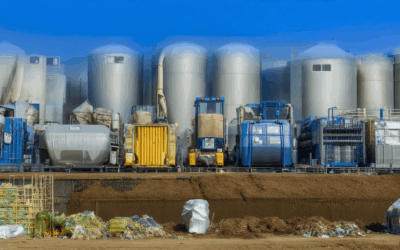Biochar, often recognized for its role as a powerful soil amendment, is emerging as a fascinating avenue for harnessing renewable energy. As the world increasingly turns toward sustainable alternatives to traditional energy sources, biochar stands out as a versatile material with the potential to revolutionize both agricultural practices and energy production. Derived from organic waste through controlled pyrolysis, biochar not only enhances soil fertility but also offers a carbon-neutral energy solution, making it a promising component in the transition to greener energy systems. With its ability to produce stable, long-lasting energy, biochar presents an intriguing opportunity to reduce reliance on fossil fuels while mitigating climate change impacts. In this article, we will explore the potential, efficiency, and environmental benefits of biochar as a renewable energy source, examining its applications, advantages, and challenges, and delving into real-world examples of its implementation.
Key Takeaways
- Biochar acts as a powerful carbon sink, effectively sequestering CO2 and helping to reduce atmospheric emissions.
- It reduces reliance on synthetic fertilizers, lowering the carbon footprint associated with conventional farming.
- Biochar production systems achieve up to 30% less energy consumption compared to traditional methods, offering significant energy efficiency improvements.
- As a soil amendment, biochar enhances soil health and reduces the need for pesticides and chemicals, contributing to environmental sustainability.
- Modern biochar production techniques minimize air pollution, making the process more eco-friendly.
- The lifecycle assessment of biochar production emphasizes the importance of sustainable practices to maximize environmental benefits and reduce ecological impact.

Is Biochar Renewable Energy?
Biochar is not a standalone renewable energy source but plays a crucial role in supporting renewable energy systems. It is primarily produced through pyrolysis, a process that converts organic waste into a carbon-rich material. While biochar itself is not energy, its production can complement renewable energy strategies, particularly in conjunction with biomass energy.
Key Points:
- Biomass Integration : Biochar production often occurs alongside biomass energy facilities. Biomass energy harnesses organic materials to generate electricity, and the byproduct biochar captures carbon dioxide, serving dual purposes of energy production and carbon sequestration.
- Carbon Sequestration : Biochar acts as a carbon sink, removing CO2 from the atmosphere, which complements renewable energy efforts by mitigating climate impacts.
- Sustainable Sourcing : Organic materials used to produce biochar are renewable, as they can regenerate, aligning with sustainable practices.
- Efficiency and Benefits : Efficient production of biochar from organic waste enhances renewable energy strategies. Additionally, biochar improves soil health, reducing reliance on synthetic fertilizers and promoting food security.
- Co-Benefits : Beyond energy, biochar contributes to sustainable agriculture, making it a valuable component in integrated energy and farming systems.
In essence, biochar supports renewable energy by aiding in carbon capture and utilizing organic waste, fitting into a broader framework of sustainable practices.
Controversy Surrounding Biochar
Biochar has sparked debate due to several factors:
- Environmental Impact Concerns: The production process, particularly pyrolysis, raises questions about emissions and environmental sustainability. Critics argue that improper production methods may contribute to air pollution and carbon dioxide release.
- Research Discrepancies: While some studies highlight biochar’s benefits for soil health, others challenge these claims, leading to confusion among stakeholders like farmers and policymakers.
- Regulatory and Quality Issues: Lack of standardized production practices can result in varying biochar qualities, affecting its effectiveness and reliability when applied to agricultural fields.
- Economic Challenges: High production costs and competition from established soil amendments hinder biochar’s adoption, particularly for small-scale operations.
- Societal Perceptions: Biochar is viewed as a promising sustainable solution, yet skepticism arises from exaggerated claims and a lack of empirical evidence supporting its supposed miracles.
- Ethical Production Concerns: Questions surround the sourcing of raw materials and the environmental impact of producing biochar, especially if it leads to deforestation or other unsustainable practices.
Addressing these issues requires careful consideration of biochar’s production methods, regulatory frameworks, and its role in sustainable agriculture to ensure it becomes a viable solution without exacerbating existing environmental problems.

Can You Burn Biochar for Energy?
Yes, biochar can be burned for energy, but it’s important to understand the implications and applications. Biochar is a carbon-rich material produced through a process called pyrolysis, which breaks down organic matter into charcoal-like substance. While it can be burned for energy, it’s not typically considered a primary energy source due to its high carbon content and limited efficiency compared to other renewable energy options.
Key Considerations:
- Energy Production : Burning biochar produces energy, but it releases carbon dioxide, which contributes to greenhouse gases. This makes it less climate-friendly compared to other renewable energy sources like solar or wind power.
- Carbon Sequestration : One of the main benefits of biochar is its ability to act as a carbon sink. When used as a soil amendment, it helps sequester carbon and improve soil health, making it a sustainable option for agricultural applications.
- Sustainable Practices : Pyrolysium, a leader in sustainable living and eco-friendly technologies, advocates for responsible use of biochar. They emphasize that while biochar can be burned for energy, it’s most effective when used in combination with other sustainable practices to maximize its benefits.
- Alternative Uses : Beyond energy production, biochar has various applications, including soil enhancement and water filtration. Its versatility makes it a valuable resource in eco-friendly initiatives.
For more information on biochar and sustainable living, visit Pyrolysium to explore their resources and learn about innovative ways to integrate biochar into your lifestyle.
Summary:
While biochar can be burned for energy, its primary value lies in its ability to sequester carbon and promote sustainable practices. To fully harness its potential, consider combining it with other eco-friendly techniques and explore the resources available at Pyrolysium .

Understanding the CO2 Footprint of Biochar
Biochar, a carbon-rich material derived from the pyrolysis of organic waste, plays a crucial role in mitigating greenhouse gas emissions. Its production involves heating biomass in low-oxygen environments, which releases some CO2, though this is offset by the beneficial environmental impacts.
When applied to soil, biochar acts as a powerful carbon sink, sequestering CO2 and enhancing soil fertility. Studies indicate that biochar can sequester significant amounts of CO2 annually, with applications potentially reducing atmospheric CO2 levels.
Furthermore, biochar enhances crop yields, thereby reducing the need for synthetic fertilizers, which have a high carbon footprint. This dual benefit of carbon sequestration and reduced agricultural emissions makes biochar a promising tool in combating climate change.
Research highlights that biochar can mitigate up to 2.56 × 10^9 metric tons of CO2-equivalent emissions annually. Its ability to act as a carbon sink and promote negative priming effects, which further reduce greenhouse gas emissions, underscores its importance in achieving carbon neutrality.
By integrating biochar into sustainable agricultural practices, we can significantly reduce the CO2 footprint associated with conventional farming methods. This approach aligns with broader goals of environmental sustainability and climate resilience.
What is the Energy Efficiency of Biochar?
Biochar production involves a process called pyrolysis, which converts organic materials into charcoal-like biochar. The energy efficiency of biochar production systems varies depending on the feedstock used and the specific design of the pyrolysis reactor.
The energy efficiency of biochar production from corncobs, rice husks, and longan husks was reported as:
- Corncobs: 49.75±0.93%
- Rice husks: 31.52±0.78%
- Longan husks: 46.97±1.04%
These values indicate that biochar production systems generally require significant energy input, though the exact efficiency can vary based on factors like feedstock moisture content, carbon content, and the type of energy source used (e.g., electricity, diesel, or biomass).
When comparing biochar production to traditional farming practices, studies suggest that biochar can reduce energy consumption by up to 30% compared to conventional methods, particularly in operations that rely heavily on fossil fuels.
Economically, the payback period for biochar production systems can range from 2 to 8 years, depending on the scale of operation and local costs of raw materials and energy. Governments and organizations often provide incentives for biochar production due to its potential to mitigate climate change and promote sustainable agriculture.
To learn more about optimizing biochar production systems, visit our guide to biochar production . Additionally, the International Biochar Initiative provides comprehensive resources on biochar technology and applications.

Is Biochar Production Environmentally Friendly?
Biochar production can be considered environmentally friendly under certain conditions, but its overall impact depends on several factors:
- Carbon Sequestration: Biochar acts as a carbon sink, storing carbon from organic materials. This can help reduce greenhouse gas emissions and mitigate climate change.
- Soil Health Improvement: As a soil amendment, biochar enhances soil structure and fertility, potentially reducing the need for synthetic fertilizers and pesticides, which are harmful to the environment.
- Energy Efficiency: The energy required for biochar production should come from renewable sources to minimize its carbon footprint. Efficient production processes further enhance its environmental benefits.
- Air Pollution Concerns: While pyrolysis can emit pollutants, modern technologies and practices aim to reduce these emissions, making the process more sustainable.
- Lifecycle Assessment: Evaluating the entire production chain, including feedstock sourcing, transport, and application, is crucial. Sustainable practices at each stage maximize environmental benefits.
However, the environmental impact of biochar production varies based on:
- Production Methods: Energy sources and efficiency significantly affect its eco-friendliness.
- Feedstock Utilization: Ensuring biochar production doesn’t compete negatively with food security or other essential uses is important.
- Soil Type and Application: Effectiveness can differ depending on soil conditions and application practices.
In conclusion, biochar production offers significant environmental benefits, particularly in carbon sequestration and soil health, but its full ecological impact requires careful consideration of production practices and integration into sustainable agricultural systems. Further research and adoption of sustainable methods can enhance its role in environmental stewardship.




0 Comments